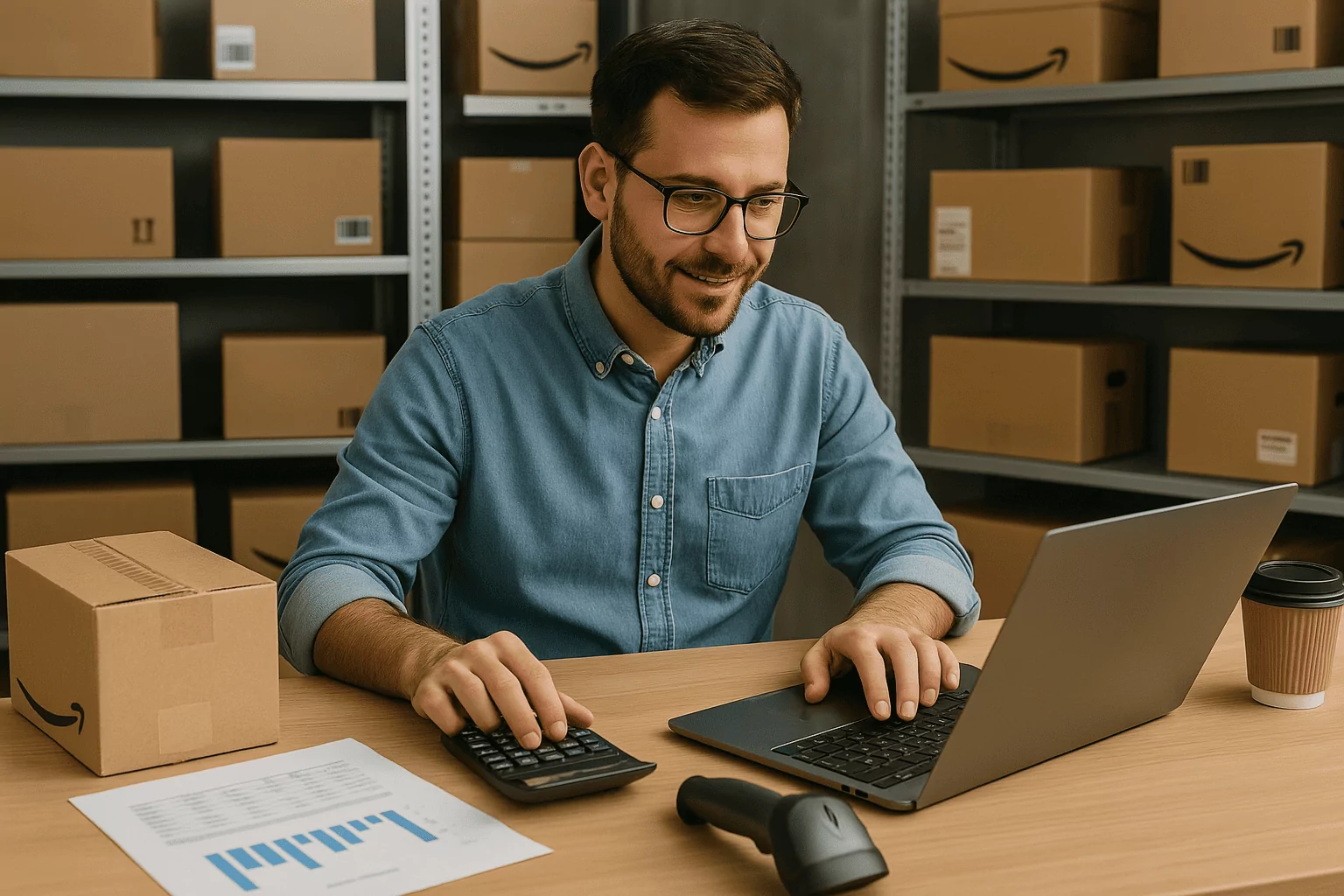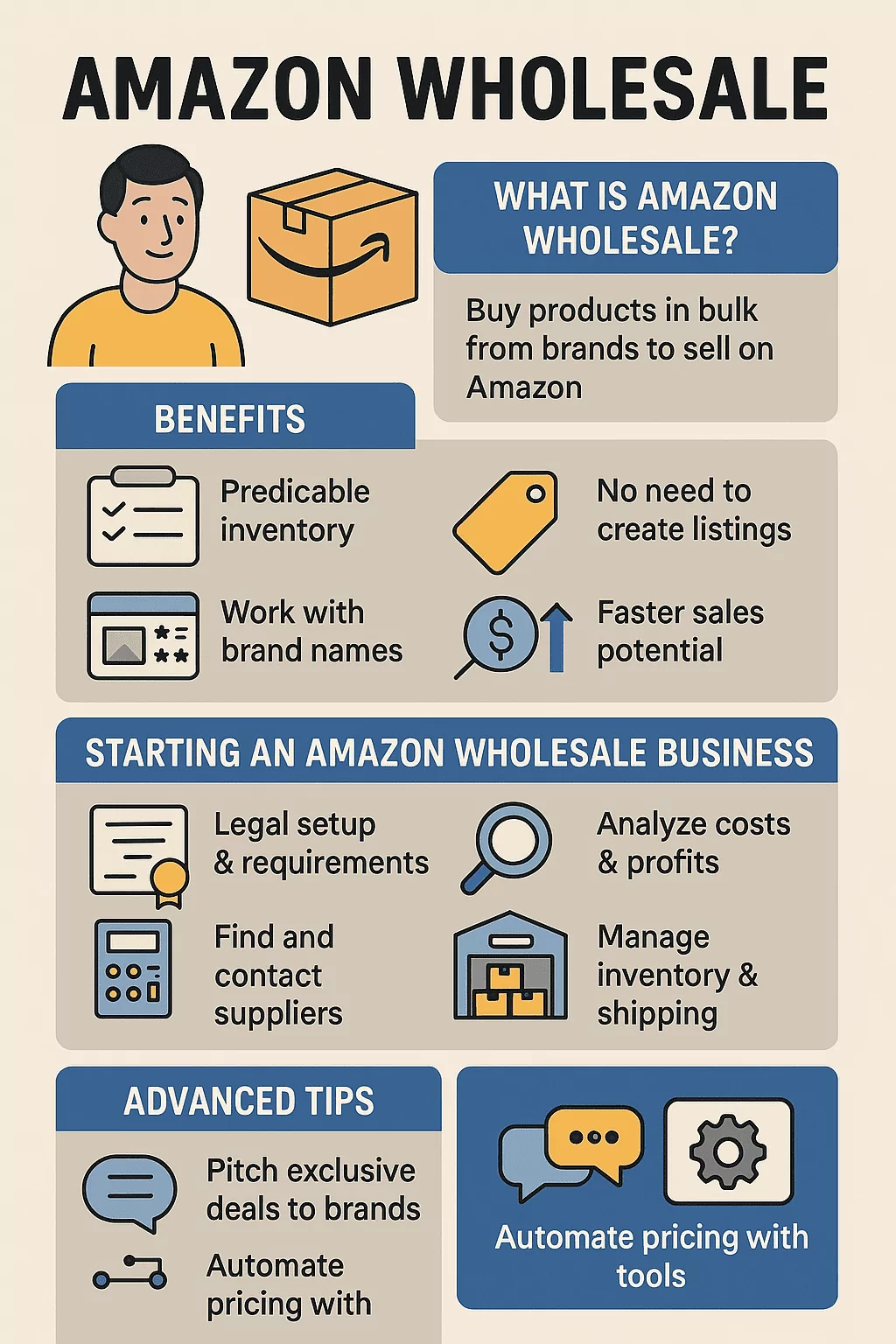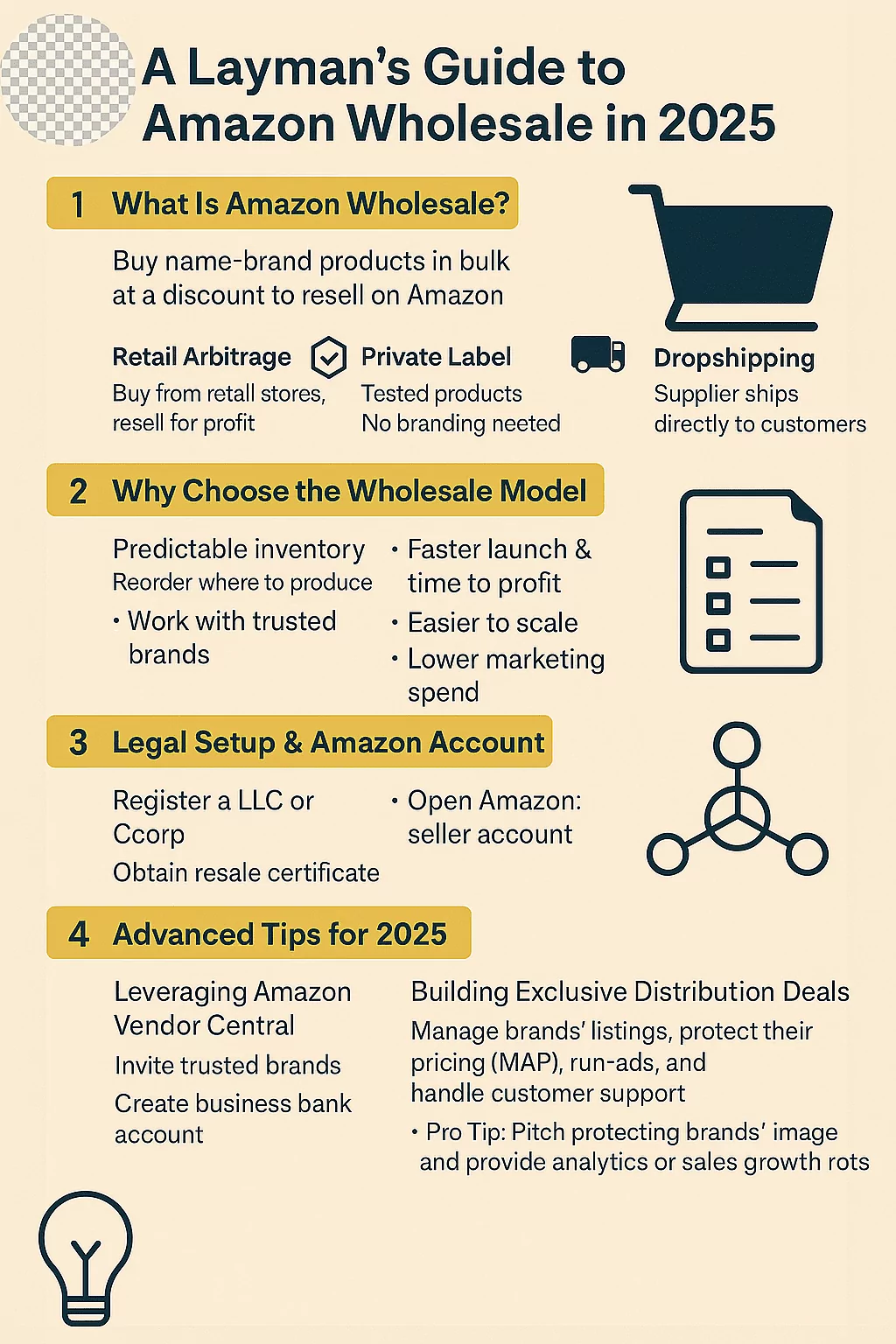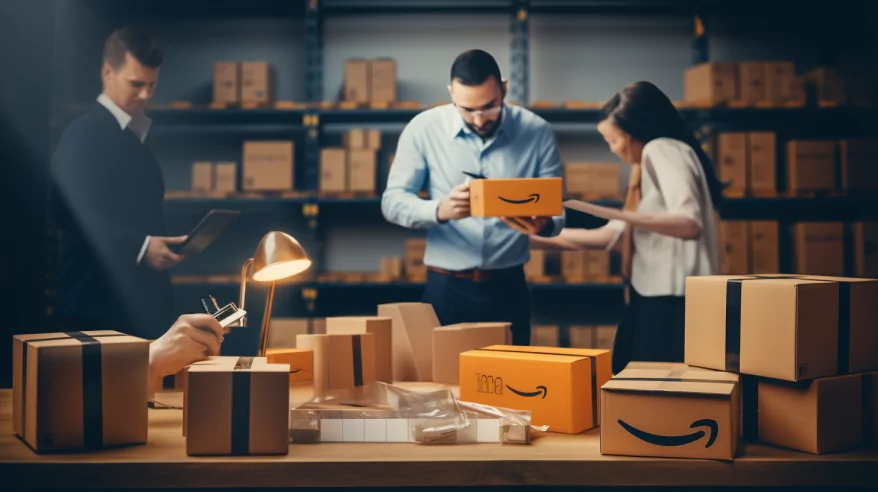Amazon Wholesale is a business model where you buy products in bulk directly from brands or authorized distributors at discounted prices, and then resell them on Amazon for a profit.
Let’s say you buy 100 units of a well-known brand’s shampoo for $4 each from an authorized supplier, and then sell each on Amazon for $10. After Amazon fees, you still make a profit on each sale — without creating your own brand.
How It’s Different from Other Amazon Models:
-
Private Label: You create your own brand and packaging (like launching “GlowPro Shampoo” instead of selling Head & Shoulders).
-
Retail Arbitrage: You find deals at local stores (like Walmart clearance) and flip them on Amazon.
-
Dropshipping: You list products you don’t stock; when someone orders, the supplier ships it directly to the customer.
Pros of Wholesale:
-
You sell trusted brands customers already know.
-
Easier to scale with bulk orders.
-
No need to build a brand from scratch.
Cons:
-
Higher upfront cost (you need to buy inventory).
-
Tough competition (many sellers may offer the same product).
-
Brands may restrict who can sell their products.
Amazon Wholesale business is a great option if you want to work with real products and skip branding hassles, but it requires smart sourcing and supplier relationships.
Key Differences between Retail and Wholesale business
Here are four key distinctions between retail and wholesale models:
- Pricing
Wholesale prices are significantly lower than retail prices because you sell in large quantities. This allows retailers to make a profit when they sell their products at the retail price.
- Quantity
Wholesale selling involves selling products in bulk, often in cases or pallets, whereas retail selling focuses on individual units.
- Target market
Wholesale sellers primarily target retailers and businesses, while retail sellers target individual consumers.
- Business model
Wholesale businesses typically operate by sourcing products from manufacturers or distributors and selling them to retailers. In contrast, retail businesses sell products directly to consumers.
Scale your brand forward on Amazon with programmatic advertising
Why Choose the Amazon Wholesale Business Model?
The wholesale model on Amazon is ideal if you want to sell real, branded products without creating your own. Here’s why it’s a great choice:
Predictable Inventory: When you work with wholesale suppliers, you can buy the same products again and again. No surprises. You don’t have to worry about inventing something new just reorder what sells.
Known Brands: Customers already trust the brands you’re selling (like Dove, LEGO, or Nike). This makes it easier to get sales, since people search for these products on Amazon every day.
No Need to Build a Brand: With wholesale, you don’t have to design logos, packaging, or branding. The product already exists. You’re just the seller.
Faster Profits: Since these products already have demand, you can start making money faster. You skip the “wait and see” phase that comes with launching a new brand.
Lower PPC Costs: PPC (pay-per-click) ads are optional with wholesale. Well-known products already have traffic, so you don’t need to spend as much on ads like private label sellers do.
👉 Example: You buy 50 units of Colgate toothpaste for $1 each and sell them at $4. Amazon takes its fee, but you still profit — without spending on branding or marketing.
Optimizing Your Amazon Ad Placements for Rest of Search (ROS)
Establishing a Business Entity and Legal Requirements
Before you start selling wholesale on Amazon, you’ll need to set up your business legally. Here’s a simple step-by-step breakdown:
Choosing the Right Business Structure
To ensure your success in the wholesale business on Amazon, it’s crucial that you consider which business structure will best suit your needs.
Here are four key factors to consider when choosing the right business structure for your successful Amazon wholesale business:
- Liability protection
Ensure your personal assets are protected in case of any legal disputes or liabilities.
- Tax benefits
Maximize your tax advantages and minimize your tax obligations.
- Flexibility
Choose a structure that allows for easy scalability and growth.
- Operational requirements
Consider the level of complexity and administrative tasks involved in each structure.
Registering for Necessary Licenses and Permits
Registering for the necessary licenses and permits is crucial to ensure compliance with legal requirements for your wholesale business.
Register Your Business (LLC or Corporation):
You need a real business, not just a personal account. In the U.S., most people start with an LLC (Limited Liability Company) because it’s easy to set up and protects your personal assets.
👉 Example: If your business gets sued, your personal money stays safe.
As an e-commerce business, it’s important to have a business license to buy products in bulk and sell them on platforms like Wholesale Amazon.
Whether you’re a private label seller or follow the wholesale model, purchasing products from suppliers requires a wholesale license.
Make sure to complete the necessary paperwork to operate your business legally.
2. Get a Resale Certificate or Sales Tax Permit:
This allows you to buy products tax-free from wholesalers and resell them legally. It’s required in most U.S. states if you’re reselling goods.
3. Apply for an EIN (Employer Identification Number):
This is like a Social Security Number for your business. You get it for free from the IRS website, and it’s needed to open accounts and work with suppliers.
4. Open a Business Bank Account:
Keep your business money separate from your personal money. Most suppliers and Amazon require payments from a business account.
👉 Example: You register “XYZ Wholesale LLC,” get an EIN, and apply for a resale certificate in Texas — now you can legally order from suppliers and sell on Amazon.
Amazon Account Setup
To start selling wholesale on Amazon, you’ll need to open and properly configure your Amazon seller account:
1. Open a Professional Seller Account:
Go to https://sellercentral.amazon.com and choose the Professional Plan ($39.99/month). This gives you access to tools and bulk listing features.
2. Get Approval for Gated Categories:
Some categories (like beauty or groceries) require Amazon’s approval before you can sell in them. This usually involves submitting invoices from legitimate wholesalers.
Example: To sell Dove soap, you may need to show Amazon a real invoice from an authorized distributor.
3. Understand Seller Central vs Vendor Central:
-
Seller Central: You sell your products to customers via Amazon.
-
Vendor Central: Only available by invite you sell to Amazon, and Amazon sells to customers.
Most wholesale sellers start with Seller Central.
4. Amazon Business Program:
You can opt in to sell to other businesses on Amazon. This can help increase bulk orders and B2B deals.
Pro Tip: Make sure your business documents match your Amazon account details to avoid verification issues.
Factors to Consider Before Entering the Wholesale Marketplace
Before diving into the wholesale marketplace, it’s important to assess your budget and ensure that you have enough capital to meet the minimum order quantity requirements. Selling wholesale on Amazon can be a lucrative opportunity, but it requires careful consideration and planning.
To build a successful Amazon wholesale business, there are several factors to consider before entering the wholesale marketplace. Firstly, you need to create an Amazon seller account and apply for a wholesale account. This will allow you to sell wholesale products on Amazon and access exclusive benefits.
Additionally, research and identify profitable wholesale products that align with your business goals. Understand the competition and demand for these products to make informed decisions.
How to Identify a Dead Keyword Before It Drains Your Budget: A Practical Guide
Lastly, establish relationships with reliable suppliers who can consistently provide high-quality products.
Conducting Market Research and Product Selection
Identifying Profitable Niche and Product to Sell
Finding profitable niches and products on Amazon requires thorough market research and a keen understanding of consumer demand. In order to sell wholesale on Amazon in 2023 and build a successful Amazon wholesale business, you need to identify the right products to sell.
Here are three key tips to help you find profitable niches and products:
- Research consumer trends and preferences
- Look for gaps in the market
- Consider selling branded products for higher profit margins
Evaluating Demand, Competition, and Trends
Evaluating demand, competition, and trends can help you determine which products have the potential to be profitable on Amazon. When you sell wholesale on Amazon, it’s crucial to stay ahead of the game.
To start selling wholesale on Amazon, learn how to evaluate demand, competition, and trends effectively. This wholesale strategy will help you find profitable products and grow your business as a successful Amazon wholesale seller.
When it comes to building relationships with suppliers, there are three key points to consider.
Identifying Potential Wholesale Amazon Suppliers
When looking for suppliers to partner with for your Amazon wholesale business, it’s important to consider the type of product you want to sell on Amazon.
Finding and Vetting Wholesale Suppliers
Finding the right suppliers is key to your Amazon wholesale success. Here’s how to do it:
1. Where to Find Suppliers:
-
Wholesale directories like Worldwide Brands or ThomasNet
-
Reach out directly to brands via email or contact forms
-
Attend trade shows like ASD Market Week or local expos
-
Contact authorized distributors of the brands you want to sell
👉 Example: You want to sell Crayola. You reach out to Crayola directly or find their official distributor online.
2. Red Flags to Avoid:
-
Middlemen pretending to be suppliers
-
Fake brand invoices
-
Poor communication or shady websites
-
No business verification
3. Sample Request Strategy: Once you find a good supplier:
-
Introduce yourself as a reseller
-
Ask for product catalogs and price lists
-
Order small samples before committing to large orders
👉 Sample Message:
“Hi, I’m John from XYZ Wholesale LLC. I’m interested in reselling your products on Amazon. Can you share your wholesale pricing and MOQ?”
The right supplier = good margins, fewer headaches, and long-term success.
How Amazon Sellers Can Capitalize on Viral TikTok Product Trends
You’ll need to find the right product that has a high demand and is profitable. Research different suppliers that offer products in bulk at competitive prices. Look for suppliers who have experience in selling wholesale products on Amazon and have a good reputation.
Consider the Amazon business model and decide if you want to sell wholesale products directly to customers or if you prefer to sell to Amazon, who will then sell them on their platform. It’s also worth exploring the option of buying wholesale products from manufacturers or using Amazon’s warehouse to fulfill customer orders.
Keep in mind that some suppliers may already be selling on Amazon, so it’s important to establish a clear agreement on how you will sell their products without causing any conflict.
By carefully selecting your suppliers and finding the right products to sell on Amazon, you can build a successful wholesale business on the platform.
2. Approaching Wholesale Product Suppliers and Negotiating Terms
When it comes to approaching suppliers and negotiating terms for your Amazon wholesale business, there are a few key points to keep in mind.
a. Crafting a Compelling Pitch
Crafting a compelling pitch is essential when you sell wholesale on Amazon. It’s the key to starting a successful Amazon wholesale business.
To make a sale on Amazon, you must grab the attention of potential buyers with your pitch. Highlight the unique features of your Amazon product and explain how it solves a problem or fulfills a need.
Show customers the value and benefits they’ll receive by purchasing your new products in large quantities.
b. Negotiating Pricing, Terms, and Exclusivity
Negotiating pricing, terms, and exclusivity can greatly impact the success of your sales on Amazon.
When it comes to negotiating pricing, make sure you’re getting the best deal possible without sacrificing your profit margin. Don’t be afraid to negotiate terms that are favorable to you, such as minimum order quantities or payment terms.
Lastly, exclusivity can give you a competitive advantage. Consider negotiating exclusive rights to sell certain products on Amazon.
Establishing a Strong Amazon Business-Supplier Relationship
When it comes to establishing a strong supplier relationship, effective communication and collaboration are key.
Effective Communication and Collaboration
Collaboration and effective communication are key in building a successful Amazon wholesale business in 2023. To thrive in this competitive marketplace, you need to harness the power of teamwork and clear communication.
Here are four reasons why effective collaboration is crucial for your Amazon wholesale business:
- Winning the Buy Box
By working together with your suppliers and partners, you can ensure that your inventory is always in stock and competitively priced, increasing your chances of winning the buy box.
- Access to Larger Quantities of Products
Through effective collaboration, you can secure larger quantities of products from your suppliers, allowing you to meet customer demand and scale your business.
- Maximize the Benefits of Wholesale
By communicating effectively with your suppliers, you can negotiate better deals, obtain exclusive discounts, and access a wider range of products, maximizing the benefits of wholesale.
- Make Money Selling Wholesale on Amazon
Collaboration and effective communication are key to maintaining strong relationships with your suppliers, ensuring timely deliveries, and providing excellent customer service, all of which contribute to your success and profitability on Amazon.
Analyzing Profit Margins and Fees in Amazon Wholesale Business
Before you buy and sell anything on Amazon, you need to make sure you’re actually making a profit. Here’s how to figure that out:
Start with Your Cost Price:
Let’s say you buy a product from a distributor for $10.
Add Amazon FBA Fees:
If you’re using FBA (Fulfilled by Amazon), they’ll charge for storage, picking, packing, and shipping. For example, that could be $5 per unit.
Include Shipping Costs:
Factor in the cost to ship your inventory to Amazon’s warehouse. Maybe that adds $0.50 per unit.
Returns and Storage Fees:
Amazon charges monthly storage fees and may charge for returns. Always leave room in your profit margin for these.
Use Profit Calculators:
Tools like the Amazon FBA Revenue Calculator or Jungle Scout’s Profit Tool can do the math for you.
Watch for MAP (Minimum Advertised Pricing):
Some brands set a minimum price you’re allowed to sell at. Going below this may get you banned from selling their products.
Example:
Buy for $10
Amazon fees = $5
Shipping = $0.50
Total cost = $15.50
Selling price = $22
Profit = $6.50 per unit
Always aim for at least a 30% margin or $5 profit per sale.
Getting Brand or Distributor Approval
To sell wholesale on Amazon, you need to build relationships with brands or authorized distributors. Here’s how to get started:
- Craft a Professional Pitch Email:
Introduce yourself as a legitimate business. Be clear that you want to buy their products for resale.
Example:
“Hi, I’m Sarah from BrightLine Trading LLC. We’re a registered business selling on Amazon. We’d love to carry your products and would appreciate your wholesale catalog.”
2. Include Business Credentials:
-
Company name and address
-
EIN (tax ID)
-
Resale certificate
-
Website or online presence
3. Tips for New Sellers:
If you’re new, start small. Request a minimum order and emphasize your professionalism. Suppliers want to work with businesses that follow MAP pricing and protect brand reputation.
4. Brand Restrictions & MAP Enforcement:
Some brands restrict who can sell their products on Amazon. If approved, you’ll need to follow MAP (Minimum Advertised Price) rules and avoid price wars.
Pro Tip: Use distributor directories like Doba, Frontier Co-Op, or Worldwide Brands to find trusted suppliers.
The goal is to build long-term, reliable relationships with suppliers who trust you.
Managing Inventory and Logistics
Once you’ve got products, you need to figure out how to ship, store, and manage them properly.
-
FBA vs FBM:
-
FBA (Fulfilled by Amazon): You ship products to Amazon’s warehouse. They handle storage, shipping, and returns.
Best for beginners. -
FBM (Fulfilled by Merchant): You store and ship orders yourself.
More control, but more work.
-
Prep Centers:
If you’re buying in bulk but don’t want to handle packaging, prep centers can label and ship your inventory to Amazon for you.
Example: You order 100 items from a distributor. A prep center checks, labels, and sends them to Amazon FBA.
-
Labeling and Packaging: Amazon requires every product to be labeled with a FNSKU barcode. Most wholesale products need poly bags or bubble wrap if fragile.
-
Reordering & Inventory Planning: Track how fast your products sell so you can reorder before stock runs out. Tools like RestockPro or InventoryLab help automate this.
A well-managed inventory = consistent sales and no lost Buy Box due to being out of stock.
Winning and Maintaining the Buy Box
The Buy Box is the white “Add to Cart” button, and owning it means more sales. Here’s how to win it as a wholesale seller:
-
Competitive Pricing: Your price needs to be close to or the same as the lowest seller. But don’t always race to the bottom — maintain profits.
-
Use Price Monitoring Tools: Tools like RepricerExpress, Aura, or BQool automatically adjust your price to stay competitive.
-
Avoid Hijackers: These are unauthorized sellers who jump on listings. To avoid them, work with exclusive suppliers or get brand authorization letters.
-
Performance Metrics Matter: Amazon gives the Buy Box to sellers who offer:
-
Fast shipping (FBA helps)
-
Low order defect rate
-
Good customer feedback
-
On-time delivery
-
MAP Compliance: If the brand has a Minimum Advertised Price, follow it. or you might lose access to their products or get kicked off the listing.
Example: You and two other sellers are offering the same product. You use FBA, have 99% feedback, and your price is fair. Amazon will likely give you the Buy Box.
Owning the Buy Box = consistent sales without extra marketing.
Inventory Management and Sourcing Wholesale Products on Amazon
In order to maximize your success in selling wholesale on Amazon in 2023, it is crucial to focus on listing products and optimizing your product pages. By using strategic keywords and compelling descriptions, you can attract more potential customers and increase your sales.
Additionally, managing inventory and handling stock levels is essential to ensure that you always have enough products available to meet demand and avoid stockouts, which can negatively impact your sales and customer satisfaction.
Listing products and optimizing product pages
When optimizing your product pages on Amazon, it’s important to focus on clear and concise product descriptions. If you want to sell your products successfully, you need to make sure that the descriptions are informative and enticing.
Wholesale is a great way to source products, especially if you’re trying to compete with Amazon. Make sure to carefully choose the products you want to sell and keep an eye on what the Amazon Warehouse Deal is selling.
Managing inventory and handling stock levels
Managing inventory and handling stock levels can be challenging, but it’s crucial for the success of your business. You need to keep track of what products you have in stock and ensure that you have enough to meet customer demand.
Amazon Wholesale Pricing Strategy
When it comes to pricing your products on Amazon, it’s important to consider costs, competition, and perceived value.
Factoring in Amazon’s referral fees and other costs is crucial in determining the right pricing strategy for your business.
Considering Costs, Competition, and Perceived Value
Considering the costs, competition, and perceived value, it’s crucial to thoroughly analyze the market before starting your Amazon wholesale business.
You want to ensure that the costs involved in sourcing and selling products align with your budget and profit margins.
Additionally, researching the competition will give you insights into pricing strategies and potential market saturation.
Understanding the perceived value of your products will help you position them effectively and stand out in a crowded marketplace.
Factoring in Amazon’s Referral Fees and Other Costs
To accurately calculate your potential profits, it’s important to factor in Amazon’s referral fees and other costs when determining the selling price of your products. These fees can vary depending on the category and price of your item, so it’s crucial to do your research and understand the costs involved.
Navigating Amazon’s Wholesale Processes
Amazon’s Vendor Central vs. Seller Central
Are you considering selling wholesale on Amazon in 2023? If so, it’s important to understand the distinctions between Amazon’s Vendor Central and Seller Central.
Both platforms have their pros and cons, and knowing the differences can help you make an informed decision.
In this discussion, we will explore the distinctions and weigh the advantages and disadvantages of each platform, so you can choose the one that best suits your business goals.
Understanding the Distinctions
Understanding the distinctions will help you navigate the world of wholesale on Amazon and make informed decisions for your business.
Here are three key distinctions to keep in mind:
- Vendor Central
This is for manufacturers and distributors who sell directly to Amazon. They handle inventory, pricing, and marketing.
- Seller Central
This is for third-party sellers who handle their own inventory, pricing, and marketing.
- Fees and Control
Vendor Central charges fees but offers less control, while Seller Central gives you more control but also more fees.
Order Fulfillment and Shipping
When it comes to order fulfillment and shipping on Amazon, you need to take advantage of their Fulfillment options to streamline your process.
By utilizing Amazon’s Fulfillment by Amazon (FBA) service, you can let them handle the storage, packing, and shipping of your products, saving you time and effort.
Additionally, it’s crucial to closely monitor the shipping and delivery processes to ensure that your customers receive their orders on time and in good condition.
This will contribute to a positive buying experience and customer satisfaction.
Utilizing Amazon’s Fulfillment Options
By utilizing Amazon’s fulfillment options, you can streamline your wholesale business and ensure timely delivery to your customers.
Amazon offers a range of fulfillment services, such as FBA (Fulfillment by Amazon), where they handle storage, packing, and shipping for you. With FBA, you can focus on sourcing products and growing your business while Amazon takes care of the logistics.
It’s a convenient and efficient way to scale your wholesale operations on Amazon’s platform.
Monitoring shipping and delivery processes
Keep an eye on the shipping and delivery processes to ensure that your customers receive their orders on time. It’s crucial for your business’s reputation and customer satisfaction.
Here are three reasons why monitoring these processes is essential:
- Avoid negative reviews and customer complaints
- Build trust and loyalty with your customers
- Increase the likelihood of repeat purchases
When it comes to optimizing your wholesale sales performance on Amazon, there are a few key points you need to keep in mind.
Utilizing Amazon Advertising
Are you looking to maximize your visibility and increase sales on Amazon? Sponsored Product Ads can be a game-changer for your business.
By utilizing these ads, you can boost your product’s visibility, reach a larger audience, and increase your chances of making a sale.
Setting up effective advertising campaigns is crucial to ensure you are getting the most out of your investment. With a well-planned strategy, you can target the right audience, optimize your ad content, and drive more traffic to your listings.
Sponsored Product Ads and their Benefits
Using Sponsored Product Ads on Amazon can greatly boost the visibility and sales of your wholesale products. By utilizing these ads, you can reach a wider audience and increase your chances of making sales.
Here are the benefits of using Sponsored Product Ads:
- Increased visibility: Sponsored Product Ads appear at the top of search results, ensuring that your products are seen by potential customers.
- Targeted advertising: You can choose specific keywords and target relevant customer segments to maximize the effectiveness of your ads.
Setting Up Effective Advertising Campaigns
To set up effective advertising campaigns, you’ll need to carefully select keywords and target specific customer segments. By choosing the right keywords, you can increase the visibility of your ads and reach the right audience.
It’s important to research and analyze the keywords that are relevant to your products and have high search volume. Additionally, identifying your target customer segments allows you to tailor your ads and messaging to resonate with their needs and interests.
Monitoring and Analyzing Wholesale Business Performance Metrics
When it comes to running a successful Amazon wholesale business, it’s crucial to monitor and analyze performance metrics.
This includes looking at sales data, customer feedback, and reviews.
Sales Data, Customer Feedback, and Reviews
While analyzing sales data, customer feedback, and reviews is important for success, it’s crucial to also take action based on the insights gained.
You need to actively respond to customer feedback and address any issues or concerns they may have.
Use the sales data to identify trends and adjust your strategies accordingly.
Don’t just passively collect information, but actively use it to improve your business and provide a better experience for your customers.
Adjusting Strategies Based on Data Insights
Use the insights gained from analyzing sales data, customer feedback, and reviews to make adjustments and improve your strategies.
By understanding what products are selling well and what customers are saying, you can optimize your wholesale business on Amazon.
Identify trends, spot areas for improvement, and adapt your approach accordingly.
Whether it’s adjusting pricing, expanding your product range, or enhancing customer service, data-driven decision-making will help you stay ahead in the ever-changing world of e-commerce.
Meeting Amazon Business Requirements and Policies
When it comes to selling wholesale on Amazon, you need to ensure that your products are authentic, in good condition, and properly packaged. This is crucial for gaining the trust of customers and maintaining a positive reputation on the platform.
Additionally, you must also be prepared to handle customer service inquiries and returns efficiently and effectively, as this plays a significant role in customer satisfaction and repeat business.
Product Authenticity, Condition, and Packaging
Selling wholesale on Amazon in 2023 requires a few key steps to ensure the authenticity, condition, and packaging of your products.
First, you need to source products directly from manufacturers or authorized distributors. This is crucial in guaranteeing the authenticity of the items you sell. By working directly with the source, you can avoid counterfeit products and maintain the trust of your customers.
Next, it’s important to carefully inspect each item before sending them to Amazon’s fulfillment centers. This step ensures that the products are in good condition and meet the quality standards expected by customers. By taking the time to inspect each item, you can catch any defects or issues before they reach the customer.
Lastly, paying attention to packaging plays a vital role in ensuring customer satisfaction and minimizing any potential damage during transit. Proper packaging not only protects the product but also creates a positive unboxing experience for the customer. This can lead to positive reviews and repeat business.
Handling Customer Service and Returns
To effectively handle customer service and returns, you’ll need to be responsive and empathetic towards customers’ concerns.
Here are four key ways to evoke an emotional response in your audience:
- Respond promptly to customer inquiries and issues, showing them that their concerns are a priority.
- Apologize sincerely for any mistakes or inconveniences caused, demonstrating empathy and understanding.
- Offer solutions and alternatives to resolve customer issues, showing that you are committed to finding a satisfactory resolution.
- Follow up with customers after resolving their concerns, ensuring their satisfaction and building trust in your brand.
Maintaining Consistent Product Quality
When it comes to maintaining consistent product quality, it’s essential to have effective supplier communication and quality assurance processes in place. By staying in close contact with your suppliers and clearly communicating your expectations, you can ensure that the products you receive meet the required standards.
Additionally, managing customer expectations is crucial in maintaining a high level of customer satisfaction. By being transparent about product features, delivery times, and any potential issues, you can avoid misunderstandings and ensure that your customers are happy with their purchases.
Supplier Communication and Quality Assurance
Communication with suppliers is essential for ensuring quality assurance in your Amazon wholesale business. By maintaining an open line of communication, you can address any concerns or issues regarding product quality promptly.
Regularly communicating with your suppliers allows you to establish a strong working relationship, which can lead to better quality control and timely resolution of any quality-related problems.
Managing Customer Expectations
Now that you’ve mastered supplier communication and quality assurance, it’s time to focus on managing customer expectations. This is crucial for building a successful Amazon wholesale business.
Here are a few key points to keep in mind:
- Understanding your target audience
- Providing accurate product descriptions
- Offering exceptional customer service
- Handling returns and refunds efficiently
Expanding Product Offerings
To really grow your Amazon wholesale business, you should consider broadening your range of products. Offering a diverse selection of products not only attracts a wider customer base but also increases your chances of making more sales.
Look for trending products that align with your target market’s interests and preferences. Conduct thorough market research to identify gaps in the market and find untapped opportunities.
Consider expanding into complementary product categories or introducing variations of your existing products. Don’t be afraid to experiment and test new products to see what resonates with your customers.
Exploring New Amazon Marketplaces
It’s essential to research and analyze new Amazon marketplaces to identify potential opportunities for expanding your business.
With Amazon’s global reach, there are numerous marketplaces available for you to explore and tap into. By expanding to new marketplaces, you can reach a wider customer base and increase your sales potential.
Start by conducting market research to understand the demand and competition in each marketplace. Look for untapped niches or product categories that align with your business.
Analyze factors such as shipping costs, taxes, and regulations to ensure a smooth expansion. Consider using Amazon’s Global Selling program to simplify the process.
Remember, each marketplace may have its own unique challenges, so adapt your strategy accordingly.
Building a Brand Presence and Customer Loyalty
By consistently delivering exceptional products and providing outstanding customer service, you can build a strong brand presence and foster customer loyalty.
When customers receive high-quality products and experience top-notch service, they are more likely to trust and engage with your brand. This trust and engagement can lead to repeat purchases and positive word-of-mouth referrals, which are essential for building a loyal customer base.
Additionally, a strong brand presence sets you apart from your competitors and helps you stand out in the crowded marketplace. It creates recognition and familiarity, making customers more likely to choose your brand over others.
Common Challenges in Wholesale Selling on Amazon
One of the most common challenges in wholesale selling on Amazon is managing inventory effectively. When you have a large number of products to sell, it can be difficult to keep track of what you have in stock and ensure that you are always ready to fulfill orders.
This is especially true if you are selling a variety of different products from multiple suppliers. It is essential to have a system in place that allows you to monitor your inventory levels, track sales, and reorder products when necessary.
By using Amazon’s inventory management tools and setting up alerts for low stock levels, you can stay organized and avoid running out of popular items. Additionally, regularly analyzing sales data can help you make informed decisions about which products to reorder and which ones to discontinue.
Effective inventory management is crucial for success in the wholesale business on Amazon.
Adapting to Changes in E-Commerce and Amazon’s Policies
Adapting to changes in e-commerce and policies on Amazon can be challenging, but it’s crucial for maintaining a successful business.
As a seller, you need to stay up-to-date with the ever-evolving landscape of e-commerce and Amazon’s guidelines. With rapid advancements in technology and shifts in consumer behavior, it’s important to be flexible and adaptable.
Keep an eye on emerging trends, such as mobile shopping and voice-activated devices, and adjust your strategies accordingly.
Stay informed about Amazon’s policies and guidelines to ensure compliance and avoid any potential penalties. Regularly review the rules and regulations, especially in areas like product listings, pricing, and customer reviews.
Advanced Strategies (2025-Level Tactics for Serious Wholesale Sellers)
Once you’ve got the basics down, here are some advanced strategies that top Amazon sellers use to scale and stand out:
1. Amazon Vendor Central Partnerships
Vendor Central is invite-only. Here, you sell directly to Amazon, and they sell to customers. If a brand trusts you, you can request to manage their Amazon presence, helping them get on Vendor Central (and taking a cut or earning exclusive rights).
Example: You help a small skincare brand scale on Amazon, and Amazon invites them to Vendor Central. You stay on as their partner.
2. Exclusive Distribution Deals
Approach brands and offer to be their only Amazon seller. In exchange, you protect their pricing and brand image.
You might say, “We’ll manage your listings, run ads, and keep pricing fair — just give us exclusive rights to sell on Amazon.”
3. Scaling with SOPs and VAs
Use Standard Operating Procedures (SOPs) to outsource tasks to virtual assistants — things like supplier research, listing uploads, or customer replies. This frees up your time to grow.
Tools That Give an Edge in 2025:
-
Keepa: Tracks product price and sales history
-
Tactical Arbitrage: Finds profitable products across websites
-
ScanUnlimited: Analyzes supplier price lists for winners
Use these tools to buy smarter and scale faster.
Compliance & Legal Considerations (Don’t Skip This Part)
To run a safe and long-term wholesale business, staying legally compliant is a must. Here’s what beginners need to know:
1. Trademark & IP Risks
You can’t sell branded products without permission. Doing so can lead to IP complaints (Intellectual Property violations) — even account suspension.
Tip: Only buy from authorized distributors or get a brand letter granting you permission to resell.
Getting Ungated in Restricted Categories
Some categories like Grocery, Beauty, or Health are “gated” (restricted). To sell in these, you need to submit invoices from trusted suppliers showing legit purchases.
In 2025, Amazon often requires at least 10 units on the invoice and clear contact info from the supplier.
Tax & Invoice Compliance
If you’re in the U.S., keep clean records of:
-
Sales tax collection by state
-
Invoices proving legal product sourcing
-
Business income reporting for the IRS
Use tools like TaxJar or A2X to automate this.
Selling Internationally?
Know the import/export laws, duties, and product compliance rules (e.g., CE marks in Europe). Amazon marketplaces like Canada or the UK are growing in 2025 but require VAT registration and local tax setup.
Example: To sell in the UK, register for a UK VAT number and charge proper tax on every order.
Conclusion
Bottom line: Do things the right way from Day 1 it protects your account and sets you up for long-term success.
By understanding wholesale selling, preparing and building relationships with suppliers, setting up your business, navigating Amazon’s processes, optimizing sales performance, and ensuring compliance and quality control, you are well-equipped to scale and grow your venture.
Remember, challenges may arise, but with determination and adaptability, you can overcome them.
Embrace future trends and stay ahead in this ever-evolving marketplace.
You’ve got this!








